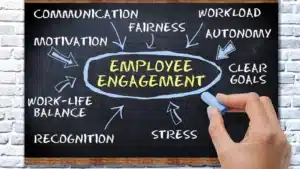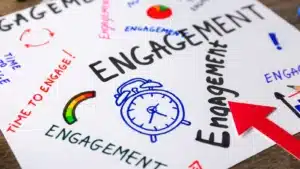
Team Engagement Ideas That Actually Work: No Eye Rolls Involved
Engaging a team can often feel like a daunting task, especially in a world where distractions are just a click away. However, fostering an environment where team members feel involved and valued is crucial for productivity and morale. Here are some innovative team engagement ideas that promise to capture attention and inspire participation, without the dreaded eye rolls.
1. Interactive Presentations
Transforming traditional presentations into interactive experiences can significantly enhance engagement. By utilizing PresEngage, presenters can turn one-way communication into a dynamic dialogue. This platform allows audience members to ask questions via SMS, ensuring that their voices are heard without the friction of app downloads or sign-ups.
Imagine a sales pitch where every team member can instantly engage with the content, ask questions, and receive real-time answers powered by AI. This not only keeps the audience engaged but also ensures that no valuable feedback slips through the cracks. The ease of participation encourages even the quieter members to contribute, fostering a more inclusive atmosphere. In addition, the integration of multimedia elements such as videos, polls, and quizzes can further captivate the audience, making the session not just informative but also entertaining. This multi-faceted approach caters to different learning styles, ensuring that everyone walks away with a deeper understanding of the material presented.
Benefits of Real-Time Q&A
Real-time Q&A features allow for immediate responses to audience inquiries, which can be a game-changer during presentations. This capability minimizes the chances of generic answers and instead provides tailored responses based on the presenter’s content. The result? A more informed and engaged audience that feels valued and heard.
Moreover, capturing audience questions and contact information during these sessions can lead to smart, automated follow-ups. This means that every interaction has the potential to convert into a business opportunity, making presentations not just informative but also productive. Additionally, the data collected can be analyzed to identify common themes or concerns among the audience, allowing organizations to refine their messaging and address specific needs in future presentations. This continuous feedback loop not only enhances the quality of future engagements but also builds a stronger relationship between the presenter and the audience.
Frictionless Participation
One of the standout features of PresEngage is the frictionless participation model. By allowing team members to engage via text message, organizations can eliminate barriers that often hinder participation. This approach is particularly effective in virtual settings, where distractions are plentiful, and engagement can wane quickly.
When team members can participate anonymously, they are more likely to ask questions and share insights without the fear of judgment. This anonymity can lead to richer discussions and a more vibrant exchange of ideas, ultimately enhancing team cohesion and collaboration. Furthermore, the ability to engage in real-time discussions can create a sense of urgency and excitement, prompting participants to think critically and respond more thoughtfully. As a result, the overall quality of the dialogue improves, leading to more innovative solutions and creative brainstorming sessions that can propel projects forward.
2. Gamification of Tasks
Gamification is a powerful tool that can turn mundane tasks into exciting challenges. By incorporating elements of game design into everyday work, teams can boost motivation and engagement. This can be achieved through various methods, such as leaderboards, point systems, or even friendly competitions. The essence of gamification lies in its ability to tap into the intrinsic motivations of individuals, making tasks feel less like chores and more like quests to conquer.
For instance, a sales team could implement a point system where members earn points for completing tasks, closing deals, or even participating in meetings. This not only makes the work more enjoyable but also fosters a sense of camaraderie as team members cheer each other on. Additionally, incorporating levels or badges that signify achievements can further enhance the experience, allowing team members to visually track their progress and strive for higher ranks within the organization.
Creating a Culture of Friendly Competition
Friendly competition can be a great motivator. By setting up challenges that encourage collaboration, teams can work together to achieve common goals while still enjoying the thrill of competition. For example, a monthly sales challenge could reward the team with the highest performance, leading to team-building activities or a celebratory lunch. Such competitions can also be themed around seasonal events or company milestones, adding an extra layer of excitement and relevance.
Such initiatives not only enhance engagement but also strengthen relationships among team members, creating a more cohesive unit that works better together. The key is to ensure that the competition remains friendly and supportive, rather than cutthroat. To further promote this culture, teams might consider sharing success stories or testimonials from participants, highlighting how collaboration and teamwork played a crucial role in their achievements, thereby inspiring others to join in the fun.
Incorporating Rewards and Recognition
Recognizing achievements, big or small, can significantly boost morale and engagement. Implementing a rewards system that acknowledges individual and team accomplishments can foster a culture of appreciation. This could be as simple as shout-outs during meetings or as elaborate as an annual awards ceremony. Moreover, integrating peer-to-peer recognition platforms can empower team members to celebrate each other’s successes, creating a more inclusive environment where everyone feels valued.
By celebrating successes, teams can create a positive feedback loop that encourages continued effort and engagement. This recognition not only motivates individuals but also reinforces the importance of teamwork and collaboration. Furthermore, incorporating tangible rewards, such as gift cards, extra time off, or experiences like team outings, can elevate the excitement surrounding achievements, making the pursuit of goals even more enticing. As teams see their hard work rewarded, they are likely to invest even more energy into their tasks, fostering a cycle of motivation and success that benefits the entire organization.
3. Regular Team Check-Ins
Regular check-ins are essential for maintaining team engagement. These meetings provide an opportunity for team members to share updates, discuss challenges, and celebrate successes. However, it’s important to ensure these check-ins are engaging and not just another item on the agenda.
Utilizing interactive tools during these meetings can help keep everyone engaged. For example, incorporating polls or surveys can encourage participation and provide valuable insights into team sentiment. This approach ensures that every team member has a voice and feels valued in the decision-making process.
Creating an Open Forum
Establishing an open forum during check-ins allows team members to express their thoughts and concerns freely. This can be facilitated through anonymous feedback tools or open discussions where everyone is encouraged to share. This transparency fosters trust and collaboration, leading to a more engaged team.
Additionally, having a dedicated time for team members to share personal achievements or challenges can strengthen relationships and promote empathy within the team. This human connection is vital for creating a supportive work environment.
Setting Clear Goals and Expectations
During check-ins, it’s crucial to set clear goals and expectations. This not only provides direction but also gives team members a sense of purpose. When everyone understands their role and how it contributes to the larger objectives, engagement naturally increases.
Moreover, regularly revisiting these goals can help teams stay aligned and motivated. Celebrating milestones along the way can further enhance engagement and foster a sense of accomplishment.
4. Team-Building Activities
Team-building activities are a classic yet effective way to enhance engagement. These activities can range from casual outings to structured workshops designed to improve collaboration and communication. The key is to choose activities that resonate with the team’s interests and dynamics.
For example, organizing a team retreat focused on skill development can be both fun and beneficial. This not only strengthens relationships but also equips team members with new tools and techniques to enhance their performance.
Incorporating Fun and Creativity
Engaging team-building activities should incorporate elements of fun and creativity. This could include escape room challenges, cooking classes, or even outdoor adventures. Such experiences allow team members to bond outside of the usual work environment, fostering stronger relationships and enhancing collaboration.
Moreover, creative activities can stimulate innovative thinking and problem-solving skills, which can be beneficial in the workplace. When team members learn to collaborate in a fun setting, they are more likely to carry that spirit into their everyday tasks.
Virtual Team-Building Options
For remote teams, virtual team-building activities can be just as effective. Online games, trivia contests, or virtual escape rooms can provide opportunities for team members to connect and engage, regardless of their physical location. These activities can help bridge the gap created by distance and foster a sense of belonging among remote employees.
Additionally, incorporating regular virtual coffee breaks or informal catch-ups can help maintain connections and keep team morale high. These casual interactions can lead to stronger relationships and a more engaged team.
5. Feedback Loops
Creating a culture of feedback is essential for team engagement. Regularly soliciting feedback from team members can provide valuable insights into their experiences and perceptions. This can be done through surveys, one-on-one meetings, or even anonymous suggestion boxes.
By actively seeking feedback, teams can identify areas for improvement and address concerns before they escalate. This proactive approach not only enhances engagement but also fosters a sense of ownership among team members.
Implementing Actionable Changes
It’s crucial to act on the feedback received. When team members see that their input leads to tangible changes, they are more likely to feel valued and engaged. This could involve adjusting processes, providing additional resources, or even changing team dynamics based on feedback.
Moreover, communicating the changes made as a result of feedback reinforces the importance of team members’ voices and encourages ongoing participation in the feedback process.
Creating a Safe Space for Feedback
Establishing a safe space for feedback is essential. Team members should feel comfortable sharing their thoughts without fear of repercussions. This can be achieved by promoting a culture of openness and respect, where diverse opinions are valued and encouraged.
Additionally, providing training on giving and receiving feedback can equip team members with the skills needed to engage in constructive conversations. This not only enhances communication but also strengthens relationships within the team.
6. Continuous Learning and Development
Investing in continuous learning and development is a powerful way to engage team members. Providing opportunities for skill enhancement not only benefits the individual but also contributes to the overall success of the team. This can be achieved through workshops, online courses, or mentorship programs.

Encouraging team members to pursue professional development can lead to increased job satisfaction and engagement. When employees feel that their growth is supported, they are more likely to be motivated and committed to their work.
Encouraging Knowledge Sharing
Creating a culture of knowledge sharing can enhance engagement and collaboration. Team members should be encouraged to share their expertise and insights with one another. This could involve hosting lunch-and-learn sessions, where team members present on topics of interest, or creating a shared knowledge repository.
By fostering an environment where knowledge is freely shared, teams can enhance their collective intelligence and drive innovation. This collaborative spirit can lead to more engaged and motivated team members.
Setting Personal Development Goals
Encouraging team members to set personal development goals can also enhance engagement. By aligning individual goals with team objectives, employees can see how their growth contributes to the success of the team. Regular check-ins to discuss progress can further reinforce commitment and motivation.
Moreover, recognizing and celebrating achievements in personal development can create a positive feedback loop, encouraging ongoing engagement and growth.
From Teamwork to True Engagement
Engaging a team doesn’t have to be a chore. By implementing innovative strategies that prioritize interaction, collaboration, and personal development, organizations can foster a vibrant and motivated workforce. From interactive presentations to gamification and continuous learning, there are countless ways to enhance engagement without the dreaded eye rolls.
Ultimately, the goal is to create an environment where team members feel valued, heard, and motivated to contribute. By embracing these engagement ideas, organizations can transform their teams into cohesive units that thrive on collaboration and innovation.
Unlock Your Team's Potential with PresEngage
Ready to take your team’s engagement to the next level? With PresEngage, you can revolutionize your presentations and meetings, ensuring every team member’s voice is heard through our AI-powered SMS Q&A platform. Say goodbye to the hurdles of app downloads and microphone shyness, and hello to seamless, real-time interaction that captures every insightful question. Whether you’re a presenter, educator, trainer, or business professional, PresEngage is designed to help you connect, answer, and convert with ease. Plus, with the unique ability to provide CRM-able data, you’re not just engaging—you’re building valuable connections. Start for FREE today and experience the power of audience engagement that truly delivers results.
Present Smarter. Engage Answer Convert Close Remarkably.
Dazzle your audience with Real-Time Q&A powered by your AI Co-Presenter.(Patent Pending)
PresEngage™ makes you look brilliant by connecting with everyone, instantly.
No Credit Card Required. 100% Risk Free.
Frictionless Audience Experience GUARANTEED.






